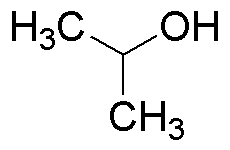Isopropyl alcohol is widely utilized in research focused on:
- Disinfection and Antiseptics: Commonly used in healthcare settings as a surface disinfectant and hand sanitizer, it effectively kills bacteria and viruses, making it essential for maintaining hygiene in hospitals and clinics.
- Solvent in Laboratories: Serves as a versatile solvent for various chemical reactions and extractions, particularly in organic chemistry, helping researchers dissolve and manipulate compounds efficiently.
- Cleaning Agent: Employed in electronics and manufacturing industries to clean delicate equipment and surfaces, it evaporates quickly without leaving residues, ensuring optimal performance of devices.
- Cosmetic Formulations: Used in personal care products like lotions and perfumes, it acts as a solvent and helps enhance the absorption of active ingredients, improving product efficacy.
- Fuel Additive: Incorporated in some fuel formulations to enhance combustion efficiency and reduce emissions, contributing to cleaner energy solutions in the automotive industry.
General Information
Properties
Safety and Regulations
Applications
Isopropyl alcohol is widely utilized in research focused on:
- Disinfection and Antiseptics: Commonly used in healthcare settings as a surface disinfectant and hand sanitizer, it effectively kills bacteria and viruses, making it essential for maintaining hygiene in hospitals and clinics.
- Solvent in Laboratories: Serves as a versatile solvent for various chemical reactions and extractions, particularly in organic chemistry, helping researchers dissolve and manipulate compounds efficiently.
- Cleaning Agent: Employed in electronics and manufacturing industries to clean delicate equipment and surfaces, it evaporates quickly without leaving residues, ensuring optimal performance of devices.
- Cosmetic Formulations: Used in personal care products like lotions and perfumes, it acts as a solvent and helps enhance the absorption of active ingredients, improving product efficacy.
- Fuel Additive: Incorporated in some fuel formulations to enhance combustion efficiency and reduce emissions, contributing to cleaner energy solutions in the automotive industry.
Documents
Safety Data Sheets (SDS)
The SDS provides comprehensive safety information on handling, storage, and disposal of the product.
Product Specification (PS)
The PS provides a comprehensive breakdown of the product’s properties, including chemical composition, physical state, purity, and storage requirements. It also details acceptable quality ranges and the product's intended applications.
Certificates of Analysis (COA)
Search for Certificates of Analysis (COA) by entering the products Lot Number. Lot and Batch Numbers can be found on a product’s label following the words ‘Lot’ or ‘Batch’.
*Catalog Number
*Lot Number
Certificates Of Origin (COO)
This COO confirms the country where the product was manufactured, and also details the materials and components used in it and whether it is derived from natural, synthetic, or other specific sources. This certificate may be required for customs, trade, and regulatory compliance.
*Catalog Number
*Lot Number
Safety Data Sheets (SDS)
The SDS provides comprehensive safety information on handling, storage, and disposal of the product.
DownloadProduct Specification (PS)
The PS provides a comprehensive breakdown of the product’s properties, including chemical composition, physical state, purity, and storage requirements. It also details acceptable quality ranges and the product's intended applications.
DownloadCertificates of Analysis (COA)
Search for Certificates of Analysis (COA) by entering the products Lot Number. Lot and Batch Numbers can be found on a product’s label following the words ‘Lot’ or ‘Batch’.
*Catalog Number
*Lot Number
Certificates Of Origin (COO)
This COO confirms the country where the product was manufactured, and also details the materials and components used in it and whether it is derived from natural, synthetic, or other specific sources. This certificate may be required for customs, trade, and regulatory compliance.


